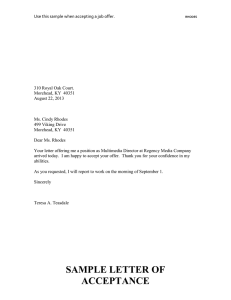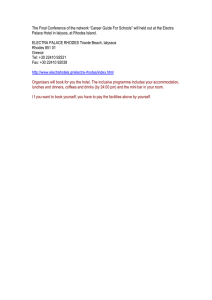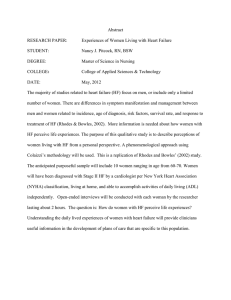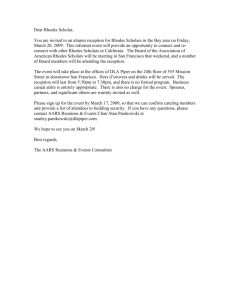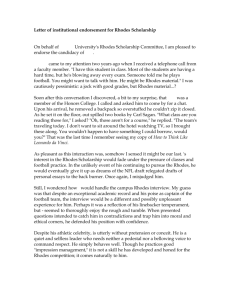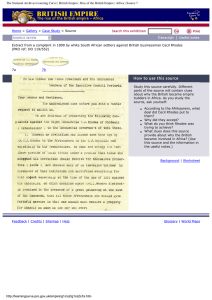Design and Implementation of an Educational ... for a Historic Home Student Jehan Moghazy
advertisement
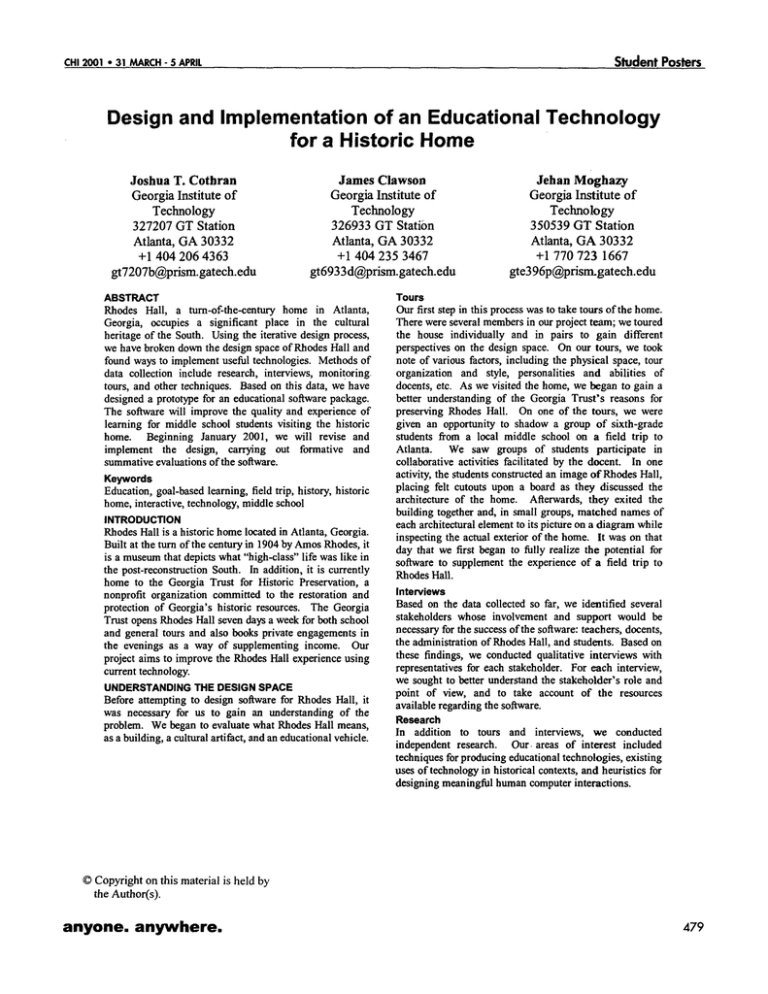
Student Posters CH12001 • 31 MARCH-5 APRIL Design and Implementation of an Educational Technology for a Historic Home J o s h u a T. C o t h r a n Georgia Institute o f Technology 327207 G T Station Atlanta, G A 30332 +1 404 206 4363 gt7207b@prism.gatech.edu James Clawson G e o r g i a Institute o f Technology 326933 G T Station Atlanta, G A 30332 +1 404 235 3467 gt6933d@prism.gatech.edu ABSTRACT Rhodes Hall, a turn-of-the-century home in Atlanta, Georgia, occupies a significant place in the cultural heritage of the South. Using the iterative design process, we have broken down the design space of Rhodes Hall and found ways to implement useful technologies. Methods of data collection include research, interviews, monitoring tours, and other techniques. Based on this data, we have designed a prototype for an educational software package. The software will improve the quality and experience of learning for middle school students visiting the historic home. Beginning January 2001, we will revise and implement the design, carrying out formative and summative evaluations of the sofiware. Keywords Education, goal-based learning, field trip, history, historic home, interactive, technology, middle school INTRODUCTION Rhodes Hall is a historic home located in Atlanta, Georgia. Built at the turn of the century in 1904 by Amos Rhodes, it is a museum that depicts what "high-class" life was like in the post-reconstruction South. In addition, it is currently home to the Georgia Trust for Historic Preservation, a nonprofit organization committed to the restoration and protection of Georgia's historic resources. The Georgia Trust opens Rhodes Hall seven days a week for both school and general tours and also books private engagements in the evenings as a way of supplementing income. Our project aims to improve the Rhodes Hall experience using current technology. UNDERSTANDING THE DESIGN SPACE Before attempting to design sottware for Rhodes Hall, it was necessary for us to gain an understanding of the problem. We began to evaluate what Rhodes Hall means, as a building, a cultural artifact, and an educational vehicle. Jehan Moghazy Georgia Institute of Technology 350539 G T S t a t i o n Atlanta, G A 3 0 3 3 2 +1 770 723 1667 gte396p@prism.gatech.edu Tours Our first step in this process was to take tours of the home. There were several members in our project team; we toured the house individually and in pairs to gain different perspectives on the design space. On our tours, we took note of various factors, including the physical space, tour organization and style, personalities and abilities of docents, etc. As we visited the home, we began to gain a better understanding of the Georgia Trust's reasons for preserving Rhodes Hall. On one of the tours, we were given an opportunity to shadow a group of sixth-grade students from a local middle school on a field trip to Atlanta. We saw groups of students participate in collaborative activities facilitated by the docent. In one activity, the students constructed an image of Rhodes Hall, placing felt cutouts upon a board as they discussed the architecture of the home. Afterwards, they exited the building together and, in small groups, matched names of each architectural element to its picture on a diagram while inspecting the actual exterior of the home. It was on that day that we first began to fillly realize the potential for software to supplement the experience of a field trip to Rhodes Hall. Interviews Based on the data collected so far, we identified several stakeholders whose involvement and support would be necessary for the success of the software: teachers, docents, the administration of Rhodes Hall, and students. Based on these findings, we conducted qualitative interviews with representatives for each stakeholder. For each interview, we sought to better understand the stakeholder's role and point of view, and to take account of the resources available regarding the sol,ware. Research In addition to tours and interviews, we conducted independent research. Our. areas of interest included techniques for producing educational technologies, existing uses of technology in historical contexts, and heuristics for designing meaningful human computer interactions. © Copyright on this material is held by the Author(s). anyone, a n y w h e r e . 479 Student Posters DESIGNING THE TECHNOLOGY Analyzing Data Once we had collected sufficient data on Rhodes Hall, it was necessary to apply analysis techniques to give our design structure and direction. With stakeholder analysis, we analyzed interview data in terms of the background, expectations, and preferences of each person's role. With CATWOE charts, we examined the problem in terms of clients, actors, transformation, weltanschauung, owners, and environment. Next, we began to design scenarios to evaluate the needs and opportunities of the design situation. Scenarios also helped us to recognize the tradeoffs of potential design ideas in advance. In the process of our analysis, we were able to identify a specific target audience and purpose for our software: improving the experience of middle school students visiting Rhodes Hall on field trips. Curriculum Considerations For determining the subject matter of our software, there is valuable pre-existing resource---the curriculum standards provided by the state of Georgia for middle school students. Georgia history classes are primarily taught in fourth and eighth grade, which gives our design an even clearer focus. By designing the lessons we provide to be applicable to state standards, we ensure that the technology we provide will have a direct and measurable effect on the students' classroom learning experience. Also, state-directed content provides us with a wealth of resources already used in schools, many of which are easily transferrable into an electronic medium. Applying Educational Paradigms From our research findings, we decided to design software that followed a constructionist theory of learning. Constructionism is the belief that learning occurs most effectively when in the context of constructing something public, with shareable, critiquable externalizations of knowledge. Establishing Technologies In keeping with the constructionist approach, we followed a goal-based scenario style of educational technology. In a goal-based scenario, students are given situations to which they must respond and based on their answers, they receive appropriate feedback and guidance. The software that we have designed will be used by groups of students at their schools before and after visiting Rhodes Hall, using internet and/or CD-ROM technologies to deliver the software to computer labs. An example of a scenario that students would encounter is "Planning a Party at Rhodes Hall." In the software, students will be presented with questions and given three options from which to choose. For example, students will be asked, "What kind of transportation will guests be arriving in?" and be given a choice between a bicycle, an automobile, or a carriage. Initially, students will not be told what the correct answer is; their decisions will be based entirely on their preconceived notions of culture and history. The students' answers will be saved until after the 48o CHI 2001 • 31 MARCH - 5 APRIl, field trip, at which point students will work together to review and change their answers if desired. Information and hints will be provided in a multimedia format. Only then will students be told whether they decided upon the correct answer, after which they will be able to discuss and present their findings to their classmates. By asking students questions before the field trip, we prime them for the learning that will take place during their visit. When they arrive at Rhodes Hall, students will already have an appreciation for the historical and cultural significance of the home, and will have goals in mind to make their visit more enriching. The post-field trip review will further reinforce the knowledge gained during their field trip, and strengthen the connection between the students' classroom learning experience and the learning that takes place during the field trip. PROTOTYPING Currently, we have developed a solution prototype in the form of screenshots, following Nielsen and Molich's heuristic guidelines and the design specifications described above. We have begun to perform heuristic analysis of our prototype, working with middle school students to find ways that we can improve our design. FUTURE WORK Beginning January 2001, we will be transforming this project from a design into a fully functional piece of software. As our prototypes become more developed, we will be evaluating the design continually~ We will use predictive modeling, KLM-GOMS, Fitts' Law, and other approaches to improve the usability of our interface. Qualitatively, we will study the students', teachers', and docents' experiences with the soRware, using individual responses and focus groups to acquire feedback: on learning, ease of use, and other factors. Quantitatively, we will use laboratory tests to evaluate usability, and pre- and post-tests with the software to evaluate learning benefits. When the project is completed, we will carry out a summative evaluation to ascertain the efficacy of our design. ACKNOWLEDGMENTS We thank Rhodes Hail, Wendy Newstetter, Mark Guzdial, and our team members that have made this project possible. REFERENCES 1. Kearsley, G. "Learning with Software." educafion.au website, http://www.educationau.edu.au/archives/cp/, 1996. 2. Nielsen, J. "Enhancing the Explanatory Power of Usability Heuristics." CHI 94 Proceedings, Addison Wesley/ACM/SIGCHI (1994), pp. 152-158. 3. Raskin, J. The Humane Interface. Massachusetts: Addison-Wesley, 2000 Reading, 4. Reeves, T. "Evaluating What Really Matters in Computer Based Education." education.au web site, http://www.educationau.edu.au/archives/ep/reeves.]htm, 1994. CH12001
